Washing
In this light, it may seem that if you wet a tattoo, nothing bad will happen. Indeed, this is so if you strictly adhere to the washing rules indicated above. Of course, you shouldn’t do this often; a couple of times a day, morning and evening, or as dirt forms, ichor and paint droplets come out is enough. During the first 2-3 days, this phenomenon is completely normal if the tattoo does not look inflamed and the volume of fluid coming out is minimal. A new layer of healing cream is applied immediately after rinsing.
What not to do
- When showering, try to minimize water contact with your tattoo. The reason is that here it hits with a concentrated strong jet, and this is quite dangerous. Firstly, a strong jet can injure the skin, which during the first 5-6 days after the session is extremely vulnerable to external mechanical influence. Secondly, a strong jet seems to “drive” water into microscopic wounds, and this increases the risk of infection, because running water can hardly be called sterile. We have already talked about washcloths. No scrubs or sponges, no need to rub the tattoo. Ideally, you should generally cover it with film during the hygiene procedure; if it is on the thigh, forearm or shoulder, then this is very easy to do. If you placed it on your chest or back, then, well, be careful.
- You should temporarily avoid taking a bath. This cannot be done either on the second or even on the seventh day. Wait until the skin has completely recovered. Why? Firstly, prolonged contact of water with damaged skin carries the risk of infection. Secondly, a bath is usually taken with warm or hot water, and this steams the tattoo, opens the pores and can cause the release of significant amounts of pigment, which is why the design will then look faded. For the same reason, due to an increase in temperature, blood flow to the skin increases, and this promotes the release of paint and increases the risk of deformation of the contours.
- Forget swimming pools. You can return to visiting them 2 weeks after the session; this time is enough for the tattoo to heal completely. Here it’s not so much about contact with water, but about its composition. The main method of disinfection in swimming pools is chlorination, that is, the water is very hard, it sometimes has an irritating effect even on healthy skin, not to mention the one on which a tattoo was recently performed. On top of that, the pool is a physical activity, and it is also contraindicated for 2 weeks after visiting a tattoo artist, as it increases blood pressure, increases blood flow, provokes the release of pigment and blurred contours.
- Swimming in the sea and other open waters. How long is it impossible? The standard period is 2 weeks. No one can guarantee that the water will not contain harmful microorganisms and bacteria. They will happily penetrate the scratches on your skin, and the consequences of this can be disastrous, including infection and severe inflammation. The second reason is the fact that such water procedures are often associated with tanning, and at first, ultraviolet radiation is extremely dangerous for the pigment, causing it to quickly fade and fade.
So, let's summarize. If you accidentally wet a tattoo, nothing bad will happen. This is not a mantu. However, unnecessary contact with water should be avoided. To minimize the waiting time before the desired bath or pool, you should strictly follow the care recommendations and, of course, contact qualified professionals. The Syndicate Tattoo salon will perform tattoos of any complexity, help you choose a design, and develop it individually if you are not satisfied with any of the catalog options. We strictly follow the principles of sterility and antiseptic treatment, thanks to which the tattoo heals quickly and causes only minor discomfort!
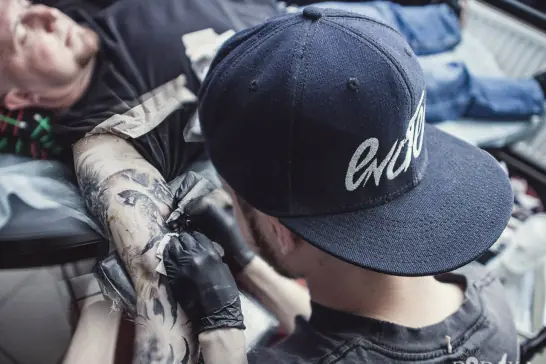
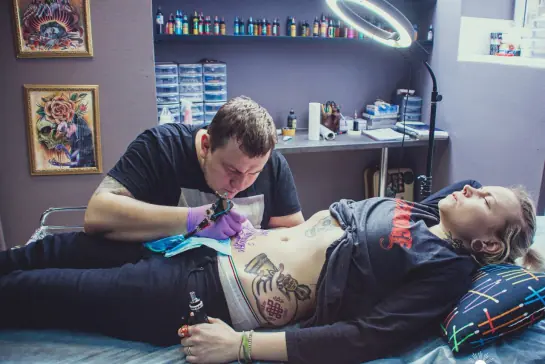
A tattoo performed by a good artist using sterile equipment and high-quality consumables does not pose a threat to human health. But you can count on a high-quality result and the absence of complications only if you carefully approach the choice of studio and artist, and also provide your tattoo with proper care.
Tattoos at Baraka studio
Sign up for a free consultation
Post-application treatment
Upon completion of work on the tattoo, the artist must apply a healing ointment to the skin area and apply a special absorbent diaper. You can walk with it for several hours. Then it is necessary to replace it for the first time, since ichor will be released from a fresh wound. Usually, traces of paint are visible on the removed bandage, or even a complete imprint of the image can be seen - this is completely normal.
After this, be sure to wash the tattoo with your hand in warm water and soap. Do not use a scrub, loofah or pumice stone! Dry the washed area with a paper or cotton towel, and then apply healing ointment to the entire surface of the tattoo (as a rule, the name of the product is indicated by the artist). It is necessary to use ointments containing panthenol (for example, Bepanten). The treated area must be sealed with a new, clean diaper. This procedure should be performed 3-4 times a day. It is especially important to change the dressings during the first 2-3 days, when ichor begins to ooze from the wound.

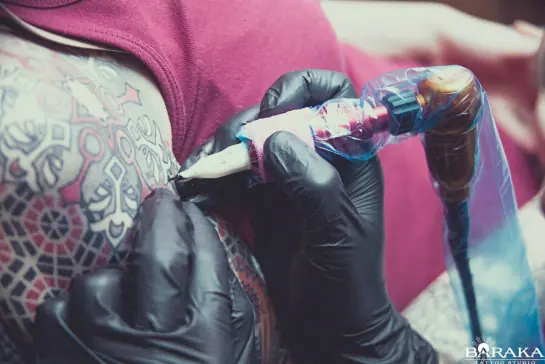
Tattoo healing
A fresh tattoo heals just like any scratch or wound. 2-4 days after going to the tattoo parlor, the ichor will stop coming out. At this stage, you need to apply healing ointment 3-5 times a day. Before each application of the ointment, the tattoo can also be washed with warm water, but under no circumstances should it be steamed.
Make sure that the tattooed area does not dry out. Do not rub, scratch or pick anything. On the 5-6th day, you can no longer cover the tattooed area with a bandage, but make sure that it does not rub against clothing.
Do not allow dirt and dust to get on a fresh tattoo. If the healing process goes well and you follow all the care rules, not a crust will form over the entire area of the tattoo, but a thin film that will quickly peel off (like skin after a sunburn).
For normal healing it is worth giving up for a while:
- visits to baths and saunas
- solarium
- going to the beach and swimming in salt water
- alcohol
Otherwise, it will prolong the healing period and, as a result, deteriorate the quality of the tattoo. Depending on the characteristics of the body, the tattoo heals in 5-10 days - provided that you carefully adhere to the rules for caring for it. After this period, you can safely use your usual skin care products without fear of harming the pattern.
A tattoo made with meaning and by the hands of a true master will decorate your body for many years and become a unique touch to your image. But in order for the design to turn out truly bright and beautiful, the tattoo must be properly cared for.
Why is it so important to pay maximum attention to the tattoo in the first three days?
One way or another, you will have to take care of your tattoo for the rest of your life. For example, it is not recommended to expose the drawing to too much sunlight - this will cause it to fade faster. In addition, the tattoo needs to be renewed periodically - since it tends to fade simply with the passage of time.

But especially careful attention should be paid to the drawing in the first three days after visiting the tattoo parlor.
- Firstly, a fresh tattoo is a wound surface - an open damage to the skin. If there is a lack of care, an infection can get into the tissue - and then the healing process will slow down, bring a lot of unpleasant sensations, and the beauty of the tattoo will be in question.
- Secondly, in the first three days, the dye applied under the skin only “sets”, and the epithelium injured during the tattooing process heals and is restored. Both lack and excess of hygiene during this period will lead to the fact that the clear contours of the picture will blur, the pigment will lose most of its brightness, the picture will be deformed and become ugly. To avoid such troubles, you must carefully follow all recommendations for proper tattoo care.
In the normal course of healing, exactly three days are enough for the initial mild inflammation in the tissues to go away. After this time, the pronounced redness of the skin and severe pain should disappear.
Of course, you will have to wait at least two weeks until complete healing occurs - and it is quite possible that then you will still need a slight correction of the pattern. This is completely normal, and most tattoo artists will perform re-treatments for free. And so that the correction does not turn into a global redoing of the entire work, we will tell you in more detail about how to care for your tattoo at first.
What to do immediately after getting a tattoo
So, you visited a tattoo parlor, chose the design you liked, and an experienced artist applied it to your body. Let us note right away that, of course, different tattooists have different levels of skill. But as a rule, this is expressed in the complexity of the drawings that the master is ready to undertake, in the harmony of proportions and other aesthetic parameters. But the appearance of the tattoo after it has healed is the responsibility of the client himself. In other words, if a bright and colorful design has faded, blurred, and been erased in places two weeks after application, most likely the reason lies precisely in improper care, and not in the poor quality of the dye or the inexperience of the artist.
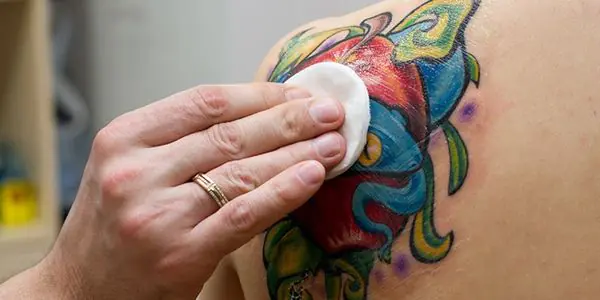
Immediately after finishing the work, the artist will temporarily cover the fresh tattoo - as a rule, with ordinary cling film, sometimes with an absorbent bandage made of an elastic bandage. In the first case, the film will need to be removed no later than after four hours - otherwise the tattoo will begin to “sag”, since the film does not allow air to pass through.
The cloth bandage can be worn for up to twelve hours at a time. But here it should be especially emphasized that we are talking about a special absorbent surface that does not stick or dry to wounds. If the master used a regular gauze bandage - which happens quite rarely - then it must be removed immediately upon returning home.
After you remove the bandage or film, the tattoo will need to be carefully washed. Don't be alarmed if you find some blood and lymph - as we already mentioned, a fresh tattoo is a wound, and these phenomena are quite normal. You need to wash the drawing with clean warm (or even slightly cool) water; you can also use baby soap or chlorhexidine solution.
It is strictly forbidden to treat fresh drawings with substances containing alcohol or hydrogen peroxide. In addition, a wet tattoo should be gently blotted with a sterile towel - without rubbing movements.
Finally, after you have washed the skin and allowed it to dry completely, the tattooed area will need to be treated with ointment. Usually, for this purpose, it is recommended to buy special formulations designed specifically for caring for tattoos. If you don’t have such a product at hand, you can use Panthenol, Bepanten or baby cream for delicate skin. Do not forget that you also need to apply the ointment very carefully - do not rub it into the skin or press it, just spread the composition over the tattoo and remove the excess with a cotton pad or napkin.
Caring for the drawing in the first three days
Basic care in the first few days is approximately the same as in the first hours. The tattoo is in the active healing phase - therefore it must be washed regularly and treated with healing compounds.
How often should a fresh tattoo be washed? This depends on the speed of healing and how intensely the damaged skin secretes blood and lymph. Hygiene procedures should be carried out at least three times a day - but not more often than once every four hours. When washing, you must adhere to the same rules:
- The tattoo is washed with clean warm water without the use of alcohol-containing substances;
- Blotting is carried out very carefully and accurately, without rubbing the skin with a towel.
After each wash, the same healing ointment is applied to the drawing, the excess amount of which is simply removed - there is still no need to rub it in.
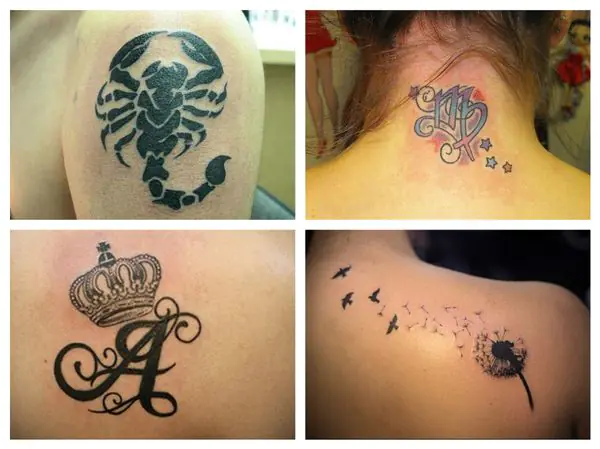
In the first two to three days, a thin crust will certainly form on the surface of the healing skin, which will cover the tattoo. What should you do with it? Almost nothing. It is strictly forbidden to tear it off, rub it or scratch it - this will not only increase the risk of infection, but also ruin the tattoo.
After some time, the crust will fall off by itself. During hygiene procedures, its small particles will spontaneously lag behind the fresh skin - so you can simply wash off the peeling crust naturally. if a small area of the crust has nevertheless been torn off, treat the micro-abrasion in the usual way, and if this affects the final appearance of the design, agree with the tattoo artist about making a correction.
How to behave until complete healing
The first few days are considered the most critical and difficult - however, the process of complete healing lasts much longer, about two weeks. Mandatory correction of the final drawing is carried out only after a month or a month and a half.
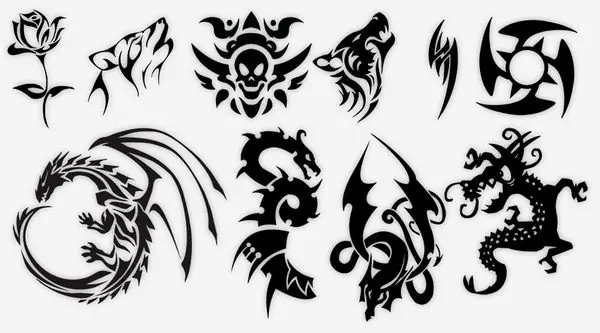
Throughout this time, the tattoo also requires careful care. What rules must be followed to ensure that the drawing remains bright, clear and beautiful?
- As already mentioned, direct exposure to sunlight is very harmful for tattoos. Excess ultraviolet radiation negatively affects even old drawings - and can have a devastating effect on a fresh tattoo. Therefore, for the first few weeks, the design must be “hidden” from the sun, choosing clothes that completely cover the tattooed area.
- The drawing needs good ventilation. Therefore, even closed clothing should be quite loose - do not wear lightweight clothes with a high synthetic content, give preference to spacious clothes made from natural fabrics.
- Of course, while your tattoo is healing, you can and should wash yourself - but for a while, avoid the pool, long baths, and especially swimming in salty sea water. Limit hygiene procedures to showering — and it is advisable to cover the tattoo site with a film during washing or at least lubricate it with a thick protective cream. Of course, it is not recommended to rub the skin with a washcloth.
In addition, until complete healing, it is recommended to avoid going to the gym - or at least minimize sports activities. The fact is that during exercise you sweat - and even with good hygiene, this can lead to irritation of the skin at the tattoo site.
You will also need to stop drinking alcohol - it has a destructive effect on the dye injected under the skin by increasing blood pressure. It is good if during the healing period of the tattoo you do not take any medications - some of them, when coming into contact with the pigment, can cause allergies.






